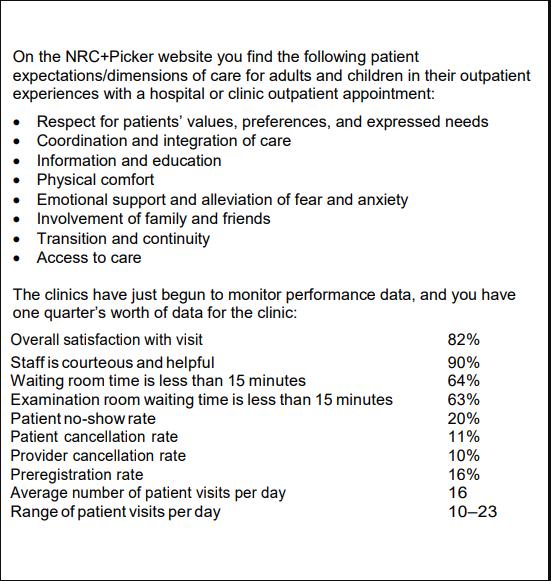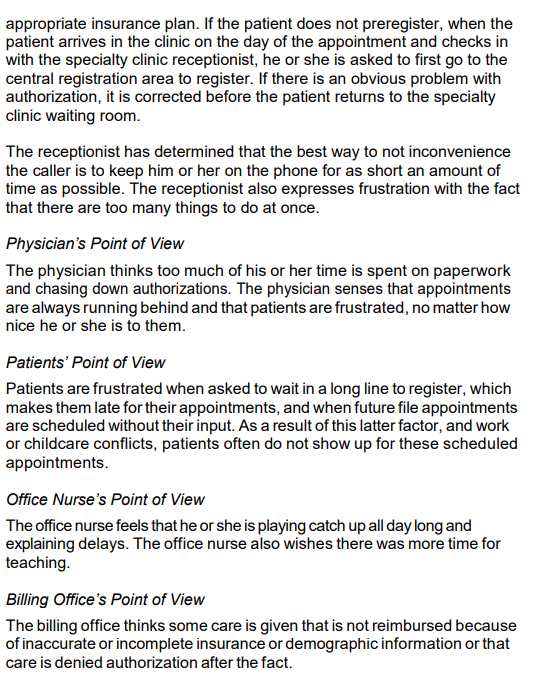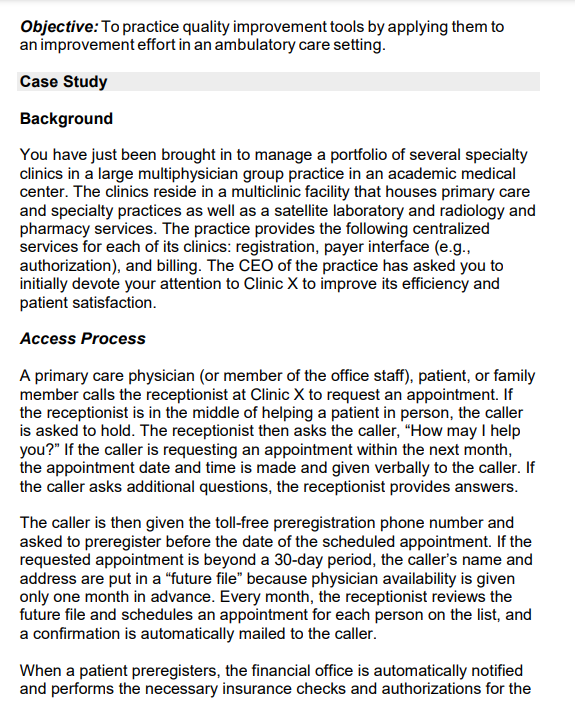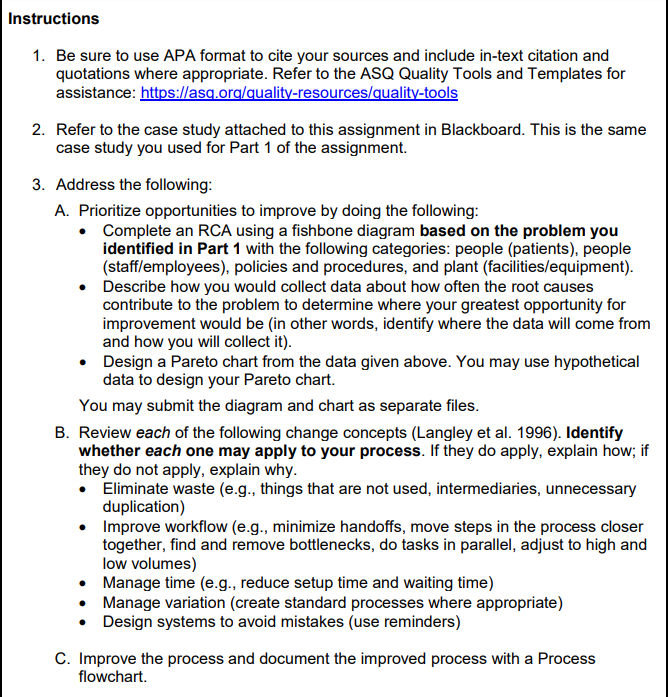Answered step by step
Verified Expert Solution
Question
1 Approved Answer
On the NRC+Picker website you find the following patient expectations/dimensions of care for adults and children in their outpatient experiences with a hospital or





On the NRC+Picker website you find the following patient expectations/dimensions of care for adults and children in their outpatient experiences with a hospital or clinic outpatient appointment: Respect for patients' values, preferences, and expressed needs Coordination and integration of care Information and education Physical comfort Emotional support and alleviation of fear and anxiety Involvement of family and friends Transition and continuity Access to care The clinics have just begun to monitor performance data, and you have Overall satisfaction with visit one quarter's worth of data for the clinic: 82% Staff is courteous and helpful 90% Waiting room time is less than 15 minutes 64% Examination room waiting time is less than 15 minutes 63% Patient no-show rate 20% Patient cancellation rate 11% Provider cancellation rate 10% Preregistration rate 16% Average number of patient visits per day 16 Range of patient visits per day 10-23 appropriate insurance plan. If the patient does not preregister, when the patient arrives in the clinic on the day of the appointment and checks in with the specialty clinic receptionist, he or she is asked to first go to the central registration area to register. If there is an obvious problem with authorization, it is corrected before the patient returns to the specialty clinic waiting room. The receptionist has determined that the best way to not inconvenience the caller is to keep him or her on the phone for as short an amount of time as possible. The receptionist also expresses frustration with the fact that there are too many things to do at once. Physician's Point of View The physician thinks too much of his or her time is spent on paperwork and chasing down authorizations. The physician senses that appointments are always running behind and that patients are frustrated, no matter how nice he or she is to them. Patients' Point of View Patients are frustrated when asked to wait in a long line to register, which makes them late for their appointments, and when future file appointments are scheduled without their input. As a result of this latter factor, and work or childcare conflicts, patients often do not show up for these scheduled appointments. Office Nurse's Point of View The office nurse feels that he or she is playing catch up all day long and explaining delays. The office nurse also wishes there was more time for teaching. Billing Office's Point of View The billing office thinks some care is given that is not reimbursed because of inaccurate or incomplete insurance or demographic information or that care is denied authorization after the fact. Objective: To practice quality improvement tools by applying them to an improvement effort in an ambulatory care setting. Case Study Background You have just been brought in to manage a portfolio of several specialty clinics in a large multiphysician group practice in an academic medical center. The clinics reside in a multiclinic facility that houses primary care and specialty practices as well as a satellite laboratory and radiology and pharmacy services. The practice provides the following centralized services for each of its clinics: registration, payer interface (e.g., authorization), and billing. The CEO of the practice has asked you to initially devote your attention to Clinic X to improve its efficiency and patient satisfaction. Access Process A primary care physician (or member of the office staff), patient, or family member calls the receptionist at Clinic X to request an appointment. If the receptionist is in the middle of helping a patient in person, the caller is asked to hold. The receptionist then asks the caller, "How may I help you?" If the caller is requesting an appointment within the next month, the appointment date and time is made and given verbally to the caller. If the caller asks additional questions, the receptionist provides answers. The caller is then given the toll-free preregistration phone number and asked to preregister before the date of the scheduled appointment. If the requested appointment is beyond a 30-day period, the caller's name and address are put in a "future file" because physician availability is given only one month in advance. Every month, the receptionist reviews the future file and schedules an appointment for each person on the list, and a confirmation is automatically mailed to the caller. When a patient preregisters, the financial office is automatically notified and performs the necessary insurance checks and authorizations for the Instructions 1. Be sure to use APA format to cite your sources and include in-text citation and quotations where appropriate. Refer to the ASQ Quality Tools and Templates for assistance: https://asq.org/quality-resources/quality-tools 2. Refer to the case study attached to this assignment in Blackboard. This is the same case study you used for Part 1 of the assignment. 3. Address the following: A. Prioritize opportunities to improve by doing the following: Complete an RCA using a fishbone diagram based on the problem you identified in Part 1 with the following categories: people (patients), people (staff/employees), policies and procedures, and plant (facilities/equipment). Describe how you would collect data about how often the root causes contribute to the problem to determine where your greatest opportunity for improvement would be (in other words, identify where the data will come from and how you will collect it). Design a Pareto chart from the data given above. You may use hypothetical data to design your Pareto chart. You may submit the diagram and chart as separate files. B. Review each of the following change concepts (Langley et al. 1996). Identify whether each one may apply to your process. If they do apply, explain how; if they do not apply, explain why. Eliminate waste (e.g., things that are not used, intermediaries, unnecessary duplication) Improve workflow (e.g., minimize handoffs, move steps in the process closer together, find and remove bottlenecks, do tasks in parallel, adjust to high and low volumes) Manage time (e.g., reduce setup time and waiting time) Manage variation (create standard processes where appropriate) Design systems to avoid mistakes (use reminders) C. Improve the process and document the improved process with a Process flowchart. D. You have completed the "Plan" phase of the Shewhart cycle. Briefly describe how you would complete the rest of the PDCA cycle.
Step by Step Solution
There are 3 Steps involved in it
Step: 1

Get Instant Access to Expert-Tailored Solutions
See step-by-step solutions with expert insights and AI powered tools for academic success
Step: 2

Step: 3

Ace Your Homework with AI
Get the answers you need in no time with our AI-driven, step-by-step assistance
Get Started


